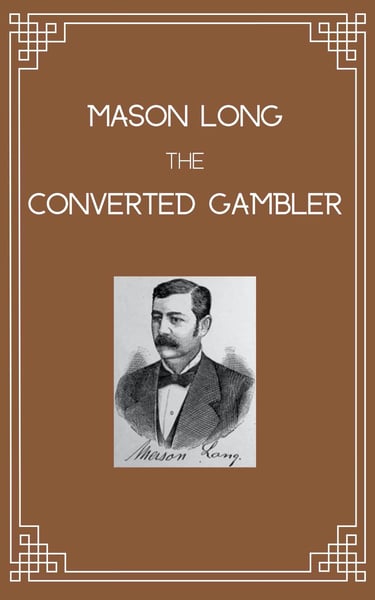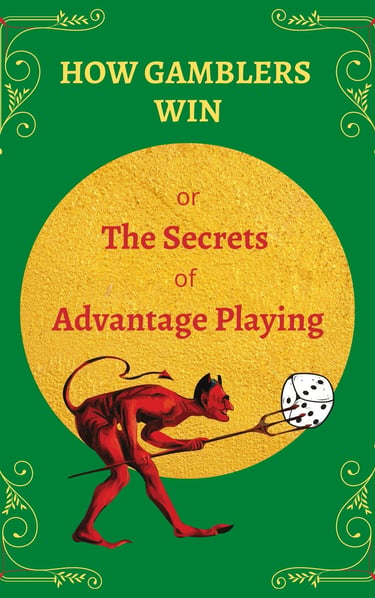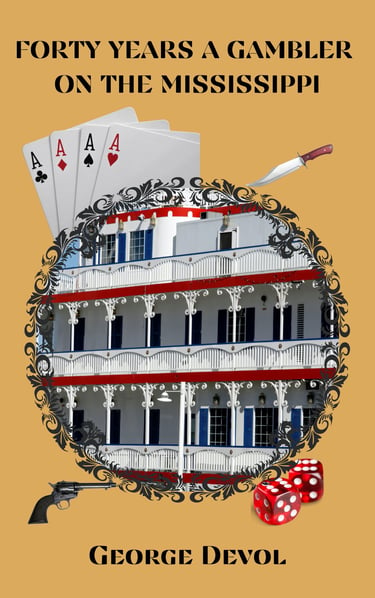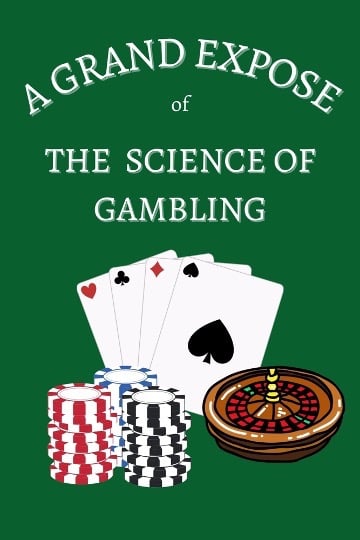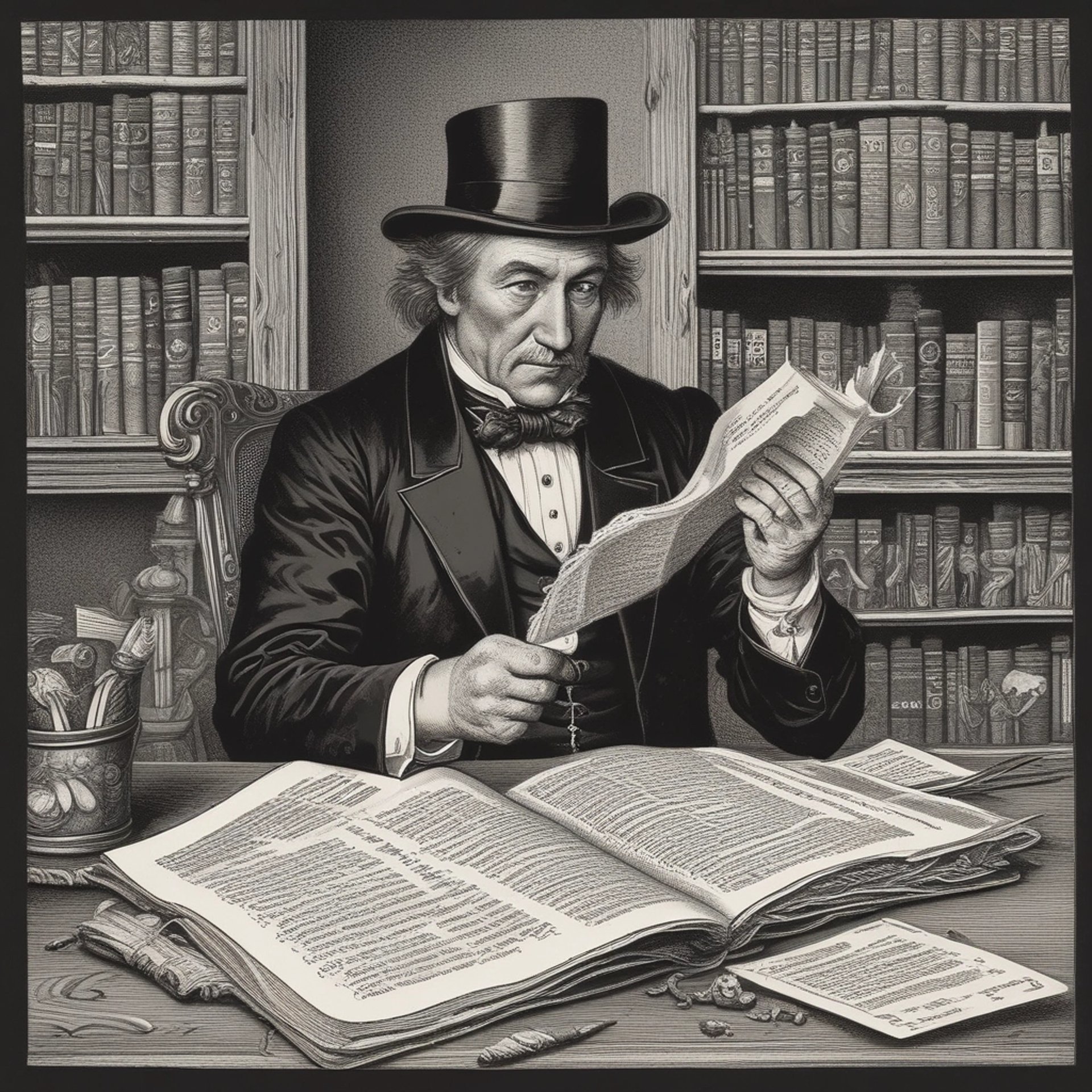
The Reviews Are In
Sharps and Flats
Sharps and Flats – A Review
By John Nevil Maskelyne
Sharps and Flats, written by John Nevil Maskelyne in 1894, is one of the earliest and most detailed treatises on the mechanics of gambling cheats. Maskelyne was a professional magician and exposer of fraud, so his approach combines showmanship with a forensic breakdown of swindling techniques. This isn’t a novel—it’s a manual of detection and prevention, aimed at card players, club members, and law enforcement of the Victorian era.
Structure & Content
The book is divided into focused sections covering:
Card table cheating – Marked cards, second dealing, bottom dealing, and “shiners.”
Dice cheating – Loading, shaving, and controlled throws.
Gaming apparatus – Roulette gaffs, mechanical devices, and concealed aids.
Psychology of the cheat – How conmen exploit trust, greed, and ignorance.
Maskelyne illustrates each method with technical precision, describing not only the mechanics but also the sleight-of-hand misdirection that enables it. He warns readers that cheats rely more on human weakness than on pure mechanical trickery.
Highlights
Illustrations: The book contains diagrams of gaffed cards, special grips for dealing, and hidden viewing devices.
Victorian Casino Culture: Gives a rare look at English gaming rooms of the late 19th century, showing that while the games have changed, the human element hasn’t.
Detailed Dice Work: His descriptions of “high men” (crooked dice) and “loaded men” are still relevant for recognizing gaffed dice today.
Early Game Protection: Maskelyne recommends surveillance, dealer rotation, and public exposure of known cheats—methods still echoed in modern casino operations.
Strengths
Historical value: One of the first comprehensive written guides to cheating.
Technical accuracy: Many of the methods he describes are still in use, albeit updated.
Educational: Serves as a foundational text for game protection training.
Limitations
Victorian bias: Maskelyne sometimes moralizes, portraying cheats as purely villainous and gamblers as naïve victims.
Outdated games: Many of the games (faro, whist, hazard) are now obsolete, so some mechanics need translation to modern contexts.
No modern surveillance context: This is purely a pre-technology, human-eye-based detection manual.
From a Game Protection Expert’s View
Reading Sharps and Flats is like stepping into the blueprint room of the early cheating trade. Many of these mechanics—marked cards, false deals, gaffed dice—haven’t changed much in principle. The real shift is in delivery: today’s cheats often rely on electronics, wireless communication, and insider collusion. However, Maskelyne’s emphasis on observation and psychology is still the bedrock of catching a cheat.
Faro Exposed
Faro Exposed – A Review
Faro Exposed is a dedicated exposé on the mechanics and scams behind Faro, the most popular gambling game in the United States from the mid-1800s to the early 1900s. Written for both historical study and practical game protection, it breaks down the way the game is played, the house’s natural edge, and—most importantly—the arsenal of cheating techniques used by dealers, players, and owners.
This work feels like a blend between a training manual for 19th-century lawmen and a warning guide for unsuspecting gamblers. While Sharps and Flats covered multiple games, Faro Exposed zeroes in on one, providing unmatched detail.
Structure & Content
The book is organized into:
History of Faro – How the game evolved from French origins (Pharaon) into the American frontier’s darling.
Rules of Play – Basic game mechanics, layout, and dealing procedure.
Honest Advantages – The statistical edge built into the game without cheating.
Cheating Methods – This is the heart of the book, with sections on:
Dealer manipulations (false shuffles, “turning the box,” and slipping cards)
Gaffed dealing boxes with hidden springs or grooves
Rigged layouts to mislead players about where bets are placed
Conspiracies between dealer and lookout
Player scams, including capping bets and sleight-of-hand chip moves
Detection & Prevention – Tells you exactly what to look for if you’re policing a Faro game.
Highlights
Mechanical Cheating Devices: Fascinating detail on “gaffed boxes” that let the dealer control which card wins or loses without visibly tampering.
Stacking the Deck: In-depth explanation of prearranging cards before the deal to favor the house.
Signals & Collusion: How confederates would signal card outcomes to a partner at the table.
Marked Cards: Subtle systems of scratching or tinting edges for identification in the deal.
Strengths
Focused Scope: Since it’s about Faro alone, the book drills much deeper into mechanics than general gambling exposés.
Historical Value: Captures the Wild West atmosphere where Faro was “king of games” in saloons and riverboats.
Device Descriptions: The diagrams and technical descriptions of cheating tools make it a valuable reference for modern game historians and protection professionals.
Limitations
Obsolete Game: Faro is virtually extinct today in live play, so most techniques are only of historical interest—though some mechanics echo in modern games like baccarat.
Moral Overtones: Like other period exposés, it sometimes lectures the reader about the folly of gambling.
Assumes Player Knowledge: Some sections jump straight into mechanics without explaining the basics, so a newcomer might get lost.
From a Game Protection Expert’s View
Faro Exposed is an important historical training document. Even though the game is gone, many of the cheat methods—gaffed equipment, stacked deals, signaling—are timeless. The physical tools may look different today, but the psychology and teamwork behind these scams remain in use, whether it’s in poker, blackjack, or baccarat.
For someone working modern casino surveillance, reading Faro Exposed sharpens your eye for physical manipulation—something technology doesn’t always catch. And for gambling historians, it’s an irreplaceable window into the most rigged game of the Old West.
The Life of Mason Long, the Converted Gambler
Mason Long
Mason Long, the Converted Gambler is a late 19th-century autobiographical work detailing the transformation of a professional gambler into a reformed Christian. First published in 1878, it was written in collaboration with Reverend William A. Hunter. Long’s story straddles the line between memoir, morality tale, and exposé of the gambling underworld.
The narrative serves two purposes:
To entertain with sensational tales of gambling dens, cheats, and confidence men.
To warn readers about the moral and financial ruin gambling brings.
Structure & Content
The book’s chapters follow Mason Long’s life in a mostly chronological order:
Early Life & Orphanhood – Establishes the poverty and hardship that shaped him.
Introduction to Gambling – How he drifted into the profession.
Life as a Professional Gambler – Detailed descriptions of poker, faro, and other popular 19th-century games, along with the tricks and cons common at the time.
Notorious Encounters – Memorable run-ins with dangerous characters, double-crosses, and brushes with the law.
Conversion & Redemption – His spiritual awakening, leading him to renounce gambling entirely.
Preaching & Reform Work – The rest of his life devoted to warning others.
Highlights
Firsthand Look at 19th-Century Gambling: Long’s descriptions of riverboat gaming rooms, saloon backrooms, and frontier faro tables give the book a cinematic quality.
Cheating Descriptions: While not as technical as Sharps and Flats or Faro Exposed, he recounts common crooked tactics—stacking decks, marked cards, and collusion.
Moral Conflict: The tension between the thrill of the game and his growing awareness of its destructiveness.
Conversion Moment: The dramatic pivot from self-described “blackleg” to man of faith is the book’s emotional high point.
Strengths
Authenticity: Written by someone who lived the life, lending credibility to the anecdotes.
Cultural Snapshot: Shows gambling not just as a pastime, but as a lifestyle intertwined with violence, vice, and camaraderie.
Engaging Storytelling: Colorful characters, close calls, and dangerous situations keep it moving.
Limitations
Moralizing Tone: Later chapters lean heavily into religious preaching, which may alienate readers looking purely for gambling history.
Lack of Technical Depth: Cheats are described in broad strokes rather than with the forensic precision of other exposés.
Self-Justification: At times, Long frames his past with a certain romanticism, even as he denounces it.
From a Game Protection Expert’s View
From a historical game protection standpoint, Long’s book is less a manual and more a cultural field report. The technical details of cheating are thin, but the environmental cues—the layout of rooms, the types of players, the social norms—are invaluable for understanding how and why certain scams thrived.
For modern readers, its value lies in context: while we can learn how 19th-century cheats operated from technical works like Sharps and Flats, Mason Long tells us who they were and why they did it.
How Gamblers Win – A Review
Author & Context
How Gamblers Win is a mid-to-late 19th-century instructional work aimed at revealing the psychology, tactics, and manipulations of professional gamblers. It’s written anonymously, but the tone suggests someone with firsthand experience—either a reformed gambler or a writer well-connected to the underworld.
The purpose of the book is twofold:
To educate the public on how gamblers operate.
To warn would-be players against engaging with them.
Structure & Content
The book blends gambling theory, practical advice, and social commentary across its sections:
The Gambler’s Persona – How cheats present themselves: charm, confidence, and apparent fairness.
Psychological Warfare – Reading opponents, manipulating emotions, and exploiting vanity or greed.
Cheating Methods – Broad descriptions of crooked play, including marked cards, stacked decks, and controlled dealing.
The Social Ecosystem – The taverns, clubs, and riverboats where gambling thrives.
How to Avoid Being Swindled – A series of moral and practical cautions.
Highlights
Psychological Insights: One of the strongest points is its emphasis on reading people. The author stresses that the gambler’s greatest weapon is understanding human weakness, not just sleight of hand.
Common Scams: Includes warnings about “boosters” (confederates who encourage others to bet), “strippers” (altered cards), and sleight-based tricks.
Lifestyle Portrait: Vivid depictions of gamblers’ dress, manners, and habits, showing how presentation and reputation were part of the con.
Blend of Skill & Luck: Explains how legitimate skill games like poker could still be used as vehicles for cheating.
Strengths
Psychological Depth: Goes beyond mechanics to show the mental game, something missing in purely technical works.
Readable Style: Written in a conversational, slightly witty tone that makes it more approachable.
Moral Clarity: Never romanticizes the gambler’s life—it portrays them as predators.
Limitations
Lack of Technical Specificity: Unlike Sharps and Flats, it doesn’t break down techniques step-by-step.
Moralizing: Like Mason Long, it sometimes becomes more sermon than manual.
Dated Social Assumptions: Uses 19th-century stereotypes and attitudes toward class and morality.
From a Game Protection Expert’s View
From my perspective as George Devol—the retired con turned casino protector—this book is valuable not for its mechanics but for its psychological profiling. Modern cheats may use microelectronics instead of sanded cards, but the personality traits, manipulation styles, and social infiltration tactics remain remarkably similar.
A modern surveillance team could take its descriptions of gambler “types” and still recognize them in today’s casino—whether they’re sitting at a poker table, chatting up dealers, or lurking at a slot bank.
If you’d like, I can now prepare a multi-book comparison matrix for Sharps and Flats, Faro Exposed, Mason Long, and How Gamblers Win—showing you where they overlap, where they differ, and what each one uniquely contributes to our understanding of gambling cheats. Would you like me to do that next?
Forty Years a Gambler on the Mississippi – A Review
George Devol
Forty Years a Gambler on the Mississippi is an autobiographical memoir attributed to George H. Devol, a notorious riverboat gambler of the 19th century. Published in 1887, it’s a blend of adventure, confession, and self-promotion, chronicling the author’s career along America’s greatest waterway during its golden age of steamboat travel.
Devol positions himself not as a repentant moralist like Mason Long, but as a colorful rogue telling war stories from the card table—though he makes no secret of his skill at separating suckers from their money.
Structure & Content
The book unfolds in short, punchy chapters, each recounting a specific episode:
Early Life & First Swindles – His boyhood introduction to gambling.
Life on the River – Tales of gaming aboard Mississippi steamboats, often against soldiers, planters, and fellow gamblers.
Con Games & Tricks – Descriptions of marked cards, cold decks, and collusion.
Famous Encounters – Memorable duels of wits with other gamblers, cheats, and lawmen.
Close Calls – Near-arrests, shootouts, and scams gone wrong.
Later Years – A mix of nostalgia and bravado about his enduring reputation.
Highlights
Steamboat Atmosphere: Vivid depictions of the social life aboard Mississippi steamers—gambling rooms thick with smoke, whiskey, and intrigue.
Cheating Details: Unlike Mason Long, Devol openly boasts about his cheating—marked cards, partner play, false shuffles—often with gleeful specificity.
Rivalries & Respect: Portrays an underworld hierarchy among professional gamblers, where skill commanded grudging respect, even among cheats.
No Regrets Tone: Devol’s voice is unapologetic, more “catch me if you can” than repentant sinner.
Strengths
Authenticity of Voice: Feels like sitting across the table from Devol himself, hearing tall tales between hands.
Action-Oriented Storytelling: Keeps the narrative moving with short, exciting episodes.
Historic Value: Offers a first-person perspective on riverboat gambling’s heyday.
Limitations
Self-Aggrandizing: Devol paints himself as the smartest man in every room, which may lead to exaggeration.
Lack of Systematic Instruction: While full of techniques, they’re embedded in stories rather than laid out as a manual.
Bias: The narrative is one-sided—his opponents are always gullible, his escapes always daring.
From a Game Protection Expert’s View
For historical game protection, Devol’s memoir is a goldmine of field anecdotes. While not a technical manual, it gives unparalleled insight into how cheats thought, behaved, and adapted. The psychological ploys—befriending marks, using charm to lower defenses, exploiting alcohol—are as relevant today as they were 150 years ago.
Devol’s attitude also matters: he frames cheating as an art form, something to be proud of. Understanding that mindset helps modern casinos anticipate and identify similar personalities in the pit.
If you want, I can now produce a side-by-side comparison of all the books we’ve reviewed so far—from Sharps and Flats to Forty Years a Gambler on the Mississippi—to map out how each one contributes to our knowledge of historical and modern cheating. That would give you a clear “cheat evolution” timeline. Would you like me to prepare that?
A Grand Expose of the Science of Gambling – A Review
Author & Context
A Grand Expose of the Science of Gambling is a 19th-century manual and exposé that blends moral warning with detailed technical breakdowns of gambling cheats. Written during a period when gambling flourished in saloons, riverboats, and private clubs, it seeks to pull back the curtain on the “black arts” of the card table and gaming hall.
Unlike purely autobiographical works like Forty Years a Gambler on the Mississippi, this one is positioned as a technical and educational guide—similar in intent to Sharps and Flats—though it still carries the period’s moral overtones.
Structure & Content
The book is organized into thematic sections:
The Gambler’s World – Descriptions of professional gamblers’ mannerisms, disguises, and lures.
Card Table Manipulation – False shuffles, second dealing, bottom dealing, and cold decking.
Marked Cards – Several marking systems, including tinting, scratching, and block work.
Mechanical Devices – Holdouts, shiners, and specialized dealing boxes.
Dice Cheating – Loaded, shaved, and “high men” dice, plus switching techniques.
Roulette & Other Gaming Tables – Rigged wheels, magnetic balls, and “percentage tables” for house advantage.
Con Games – Three-card monte and shell games as street-level counterparts to formal gambling house tricks.
Moral Conclusion – A lengthy appeal against gambling’s dangers, framing cheats as predators.
Highlights
Rich Device Detail: Explains several mechanical gaffs in depth, including their concealment and operation.
Cross-Game Coverage: Goes beyond cards to include dice, roulette, and confidence games.
Spotting Cheaters: Offers tell-tale signs of crooked play, from unnatural hand movements to suspicious betting patterns.
Period Color: Evokes the saloon-era gambling scene vividly, complete with slang and gambler archetypes.
Strengths
Breadth: Covers a wide range of games and cheating techniques.
Technical Clarity: Offers concrete explanations that could still inform game protection today.
Practical Detection Advice: While some mechanics are outdated, the observational advice is timeless.
Limitations
Moralizing Ending: The conclusion drifts into sermonizing, which can feel disconnected from the rest of the technical material.
Obsolete Games: Several games described (like faro) are now museum pieces.
Variable Depth: Some techniques get extensive coverage, while others are only mentioned in passing.
From a Game Protection Expert’s View
This book is a Swiss army knife of 19th-century cheating knowledge. It doesn’t have the firsthand storytelling charm of Forty Years a Gambler, but it makes up for it in breadth and technical variety.
For a modern casino professional, it’s less about directly applying its methods—most of these mechanical gaffs wouldn’t survive modern surveillance—and more about learning the core principles of cheating: misdirection, concealment, collusion, and exploiting human weakness. Those fundamentals are unchanged.
If you want, I can now create a comprehensive “cheating knowledge map” showing where A Grand Expose overlaps with and differs from Sharps and Flats, Faro Exposed, and the other books you’ve had me review. That would let you see the full range of historical techniques in one chart. Would you like me to prepare it?




